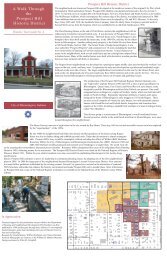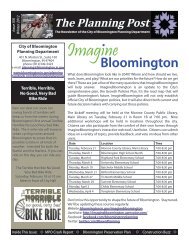Peak Oil Task Force Report - City of Bloomington - State of Indiana
Peak Oil Task Force Report - City of Bloomington - State of Indiana
Peak Oil Task Force Report - City of Bloomington - State of Indiana
Create successful ePaper yourself
Turn your PDF publications into a flip-book with our unique Google optimized e-Paper software.
11. Seek greater public investment in the transit system.<br />
Only a public transit network that is easily accessible and <strong>of</strong>fers high levels <strong>of</strong> service with<br />
regard to speed, frequency, and quality <strong>of</strong> service can truly be considered a viable option<br />
for people who can no longer afford automobile travel as fuel prices increase. A robust<br />
transit system includes service at night and during weekends, dedicated bus lanes, bus<br />
shelters, and good pedestrian access to bus stops. If the transit system requires a lot <strong>of</strong> time<br />
to negotiate and is not available when people need it, its usefulness as a transportation<br />
alternative will be very limited. The lack <strong>of</strong> robust, viable transportation alternatives will<br />
result in more severe local economic disruptions.<br />
Gas tax<br />
About 20 percent <strong>of</strong> BT’s annual operating budget is comprised <strong>of</strong> federal dollars – largely<br />
funds from the gas tax. Since 1993, approximately 18.4 cents <strong>of</strong> every gallon <strong>of</strong> gasoline is<br />
levied by the federal government to pay for roads, bridges and transit. The link between<br />
transit and the gas tax is problematic in at least two ways. First, the gas tax heavily favors<br />
the construction <strong>of</strong> roads and bridges over transit as fully 80 percent <strong>of</strong> the tax is devoted<br />
to roads and only 20 percent is dedicated to public transit. Therefore, the current system<br />
favors road building over transit and actually encourages suburbanization and a low<br />
population density that makes it difficult for BT to serve these areas. In a post‐peak future,<br />
we know this is a problematic approach. Secondly, the tax itself is unstable. Decreased<br />
demand for gasoline, as we experienced in the summer <strong>of</strong> 2008, causes gasoline revenue to<br />
drop appreciably and transit suffers.<br />
Funding<br />
As INDOT recommended in its recent analysis <strong>of</strong> transit in <strong>Indiana</strong>, to reach levels <strong>of</strong><br />
service necessary to realize even modest increases in ridership, an increase in funding<br />
must come from the local or regional level. 174 Local funding is critical considering that a<br />
post‐peak environment will occasion both 1) increased demand for transit and 2)<br />
decreased state and federal funding.<br />
174 <strong>Indiana</strong> Department <strong>of</strong> Transportation, Executive Summary, <strong>Indiana</strong> Mass Transit Studies PL 203‐2007<br />
(December 2008).<br />
<strong>Report</strong> <strong>of</strong> the <strong>Bloomington</strong> <strong>Peak</strong> <strong>Oil</strong> <strong>Task</strong> <strong>Force</strong><br />
146









